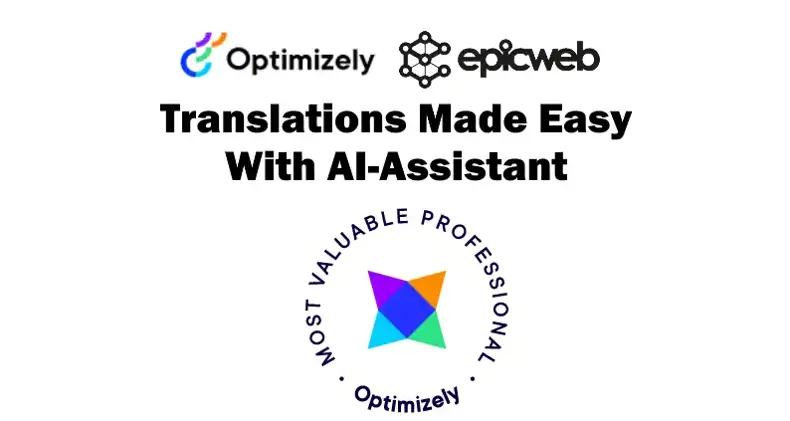
Working with Translations in Optimizely
Ensuring that content is accessible and comprehensible in multiple languages is essential for any global business. Optimizely, combined with Language Manager and Epicweb AI-Assistant, provides strong translation capabilities, making the process smooth and efficient. The integration of Epicweb AI-Assistant enhances these capabilities, offering a high degree of configurability for customized translation experiences. This post examines the key features and implementations that facilitate straightforward and effective translation work in Optimizely.
Key Features of the Epicweb AI-Assistant's Translation Capabilities
The Epicweb AI-Assistant's translation features are designed to cater to various needs, whether you're dealing with single fields or entire pages. Here are some of the standout features:
1. Translate One Field at a Time: This feature provides precision, allowing you to focus on translating specific fields without affecting other content. It’s particularly useful when only parts of a page need to be updated or when testing translations on specific sections.
2. Translate All Fields on a Page or Block Type with the LanguageManager Plugin: For a more comprehensive approach, the LanguageManager plugin allows you to translate all fields on a page or block type in one go. This feature is ideal for large-scale content updates where consistency across all fields is essential.
3. Connect Any AI Vendor: One of the most significant advancements in our AI Assistant for Optimizely is the ability to connect any AI vendor or translation services to all fields within the CMS and Commerce. This flexibility allows businesses to choose the AI services that best meet their needs, ensuring that their translation processes are as efficient and accurate as possible.
Video: Translations with Language Manager + AI-Assistant:
How Do Translations Work?
The AI-Assistant’s translation capabilities are powered by various AI vendors and LLMs, including OpenAI, which supports over 86+ languages. This extensive language support ensures that businesses can reach a global audience with translations that are not only accessible but also highly accurate. OpenAI's translation service, among others, is recognized for delivering some of the most precise and high-quality translations available worldwide.
One of the key advantages of using this service is the ability to provide specific terms or translation guidelines. These guidelines allow businesses to tailor the translation process according to their specific needs, ensuring that industry-specific terminology, brand language, and regional nuances are accurately captured. This level of customization helps maintain consistency and relevance across all translated content.
New Features for Enhanced Customization
We've introduced several new features in our AI Assistant for Optimizely, significantly enhancing the customization options available to users. A highlight of these updates is the ability to customize AI instructions for each translation language. This includes the option to use different AI models for different languages, providing unparalleled flexibility in managing multilingual content.
This feature allows customers to:
- Include Specific Translation Guidelines: Tailor the translation process to reflect the unique requirements of each language, ensuring that critical terms and brand-specific language are accurately translated.
- Use Specially Trained Models for Each Language: For businesses that operate in highly specialized fields or regions, the ability to use different AI models for different languages ensures that translations are not only accurate but also contextually appropriate.
- Customize AI Instructions Per Language: This ensures that each language's unique characteristics are considered, making the translation process more nuanced and precise.
Google Translation Hub Integration
With a custom integration of Google Translation Hub, businesses can leverage the power of Cloud Translation to dynamically translate content across multiple languages.
Moreover, the support for Glossary and translation memory allows businesses to maintain consistency in terminology and improve translation accuracy over time. This means that specific terms related to a brand or product can be translated uniformly across all content, enhancing brand identity and customer experience.
By connecting Google Translation Hub to the AI Assistant for Optimizely, businesses can streamline their translation workflows, reduce manual effort, and ultimately provide a better experience for their multilingual customers.
Implementing IAssistantInstructionsResolver
The implementation of the IAssistantInstructionsResolver interface is central to customizing translation instructions across different languages. This interface is crucial for businesses that require flexibility in how translations are handled, providing the ability to implement global 'Assistant Instructions' while also allowing for variations between languages if necessary.
Here’s a look at the interface:
public interface IAssistantInstructionsResolver{ string GetInstructions(CultureInfo language); string GetInstructionsForTranslations(CultureInfo toLanguage, CultureInfo? fromLanguage = null);}
This interface allows for the customization of instructions that guide the translation process, ensuring that the AI Assistant follows specific rules and guidelines tailored to each language's needs.
Introducing IAssistantModelResolver
In addition to the IAssistantInstructionsResolver, we have also introduced the IAssistantModelResolver interface. This interface is designed to offer even greater flexibility in managing translations by allowing the selection of different AI models based on language requirements.
Here’s the interface:
public interface IAssistantModelResolver{ string GetModelForTranslations(CultureInfo toLanguage, CultureInfo? fromLanguage = null);}
The IAssistantModelResolver interface enables businesses to:
- Select AI Models Based on Language: This is particularly useful for organizations that operate across diverse linguistic regions and require different AI models to handle the nuances of each language effectively.
- Enhance Translation Accuracy: By selecting the most appropriate AI model for each language, businesses can ensure that translations are not only accurate but also contextually relevant.
- Tailor the AI Model to Specific Needs: Whether it’s a general-purpose model or a specially trained one for a particular industry or locale, this interface provides the flexibility needed to meet diverse translation requirements.
Leveraging the "GetInstructionsForTranslations" and "GetModelForTranslations" APIs
When working with translations in Optimizely, the GetInstructionsForTranslations and GetModelForTranslations APIs are essential tools. These APIs allow for a high degree of customization in the translation process:
- GetInstructionsForTranslations: This API allows you to provide translation instructions tailored by language, ensuring that translations are conducted according to specific guidelines.
- GetModelForTranslations: This API enables the selection of the most suitable AI model for each language, enhancing the translation's accuracy and contextual relevance.
These APIs, when used in tandem, offer a comprehensive solution for managing translations across multiple languages with precision and consistency.
Examples working with AI-Assistant and Translations
Scenario 1: English to Swedish Context Conversion: If you have an English page with text in the "page description" property, simply change the context to Swedish, spin the wheel, and watch as the addon automatically translates the field. It simplifies the localization process, allowing you to cater to specific language preferences.

Scenario 2: English to Swedish Translation: When working in a Swedish context, paste the English text into the addon, spin the wheel, and witness the automatic translation into Swedish. It's quick, accurate, and saves you the hassle of manual translation.

Scenario 3: Translate Text to Any Language: No matter the language, the addon can translate your text effectively. From Spanish and French to Chinese and Arabic, the multilingual text translation feature ensures your message reaches a global audience.

Conclusion
Optimizely, combined with Language Manager and Epicweb AI-Assistant, offers a robust and highly configurable solution for businesses looking to manage multilingual content effectively. By leveraging features like field-specific translations, the comprehensive LanguageManager plugin, and the ability to connect any AI vendor, along with implementing custom assistant instructions and fine-tuned models, you can ensure that your translations are precise, consistent, and tailored to your global audience's needs.
The recent additions to our AI Assistant, including the ability to customize AI instructions per language and the option to use different AI models for different languages, provide unparalleled flexibility and precision in managing translations. These innovations ensure that your content remains relevant and impactful, regardless of the language. Stay tuned for more updates as we continue to enhance our translation capabilities to meet the needs of a global market.
Boka ett möte för att komma igång!
Vi erbjuder ett timmes introduktionsmöte om vår AI-assistent för Optimizely CMS 12. (Svenska eller engelska)
AI-assistenten: Det här får du
Funktionsrik för ökad redaktionell effektivitet
Epicwebs AI-assistent har en imponerande mängd funktioner:
-
Textförslag och alternativ: Förbättra ditt skrivande med AI-genererade formuleringar och alternativa varianter.
-
Flerspråkig översättning: Översätt din text sömlöst till flera språk samtidigt som formattering och stil bevaras för att nå en mångsidig publik.
-
SEO, AEO och GEO: Generera optimeringsinnehåll för sökmotorer och AI-sökning.
-
Prompt Pro Assistance: Det sparar tid och hjälper dig få mer ut av dina idéer, omedelbart.
-
Bild AltText-analysator: Avancerade AI-funktioner för att analysera bilder och automatiskt fylla i medieobjektsegenskaper.
-
Bildgenerering: Skapa relevanta och engagerande bilder som kompletterar ditt innehåll.
-
Bildtransformer: Ta vilken bild som helst, förbättra den och lägg till nya element med AI-driven kreativitet. Förändra sättet du interagerar med bilder.
-
Ny textgenerering: Generera nytt innehåll som håller din publik engagerad.
-
Textsammanfattning: Snabbt kondensera långa texter till koncisa sammanfattningar, spara tid och behålla essensen, perfekt för SEO-beskrivningar.
-
HTML-formatering: AI-assistenten erbjuder en rad formateringsmöjligheter inom Rich Text Editor. WCAG-kompatibel.
-
Stavningskontroll: Säkerställ att ditt innehåll är fritt från fel och professionellt polerat.
-
Tonaljustering och konsekvens: Anpassa din texts ton för att passa ändamålet och bibehålla en konsekvent varumärkesröst.
-
Nyckelordsutvinning: Identifiera och extrahera nyckeltermer från din text för SEO-optimering.
-
Anpassade uppmaningar med ChatGPT: Utnyttja kraften i ChatGPT för att köra egna uppmaningar för unik innehållsskapande.
-
Anpassade genvägsuppmaningar: Lägg till egna genvägar för frekvent använda kommandon, koppla verktyg och öka produktiviteten.
-
Inline ChatGPT-hjälp: Använd ChatGPT eller Google GEMINI direkt inom plattformen för omedelbar hjälp.
-
Verktyg för AI: Anslut dina C# Funktionsanrop eller MCP-verktyg direkt till AI-assistenten, vilket möjliggör anpassade integrationer.
-
RAG (Retrieval-Augmented Generation): Anslut din egen kunskapsbas för AI-svar som drivs av din organisations interna data.
Smidig integration i Optimizely
AI-assistenten är sömlöst integrerad i varje fält inom Optimizely CMS och Commerce-plattformen, vilket säkerställer att dessa kraftfulla funktioner är tillgängliga precis där du behöver dem, i redigerarläget.
Kom igång med Epicwebs AI-assistent:
För att komma igång med den kostnadsfria utvärderingen, fyll enkelt i formuläret på vår webbplats för att komma igång och ladda ner tillägget till din Optimizely CMS och anpassningsbara Commerce-plattform från Optimizely Nuget-feed.
Följ vår nybörjarvänliga guide eller dyka djupt med vår omfattande dokumentation.
Installation är snabb och enkel, vilket gör att du kan börja utnyttja kraften i AI-assistans på nolltid.
Boka ett möte för att komma igång!
Vi erbjuder ett timmes introduktionsmöte om vår AI-assistent för Optimizely CMS 12. (Svenska eller engelska)
Notera: Detta blogginlägg har förbättrats med hjälp av AI-assistenten för Optimizely.
AI-assistenten i Optimizely ökar din produktivitet och frigör tid, se filmen:
